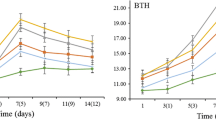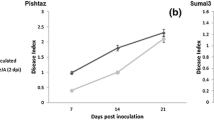Abstract
Induced resistance was studied in three sorghum genotypes (IS2205, ICSV1 and ICSV700) against Chilo partellus (Swinhoe) (Lepidoptera; Pyralidae) infestation and jasmonic acid (JA) and salicylic acid (SA) application. The activity of plant defensive enzymes [peroxidase (POD), polyphenol oxidase (PPO), superoxide dismutase (SOD), and catalase (CAT)], and the amounts of total phenols, hydrogen peroxide (H2O2), malondialdehyde (MDA), and proteins were recorded at 6 days after infestation. The induction of enzyme activities and the amounts of secondary metabolites varied among the genotypes and treatments. The genotype IS2205 showed a stronger effect than that of ICSV1 or ICSV 700. Treatment with JA followed by insect infestation induced greater levels of enzymes and secondary metabolites. The results suggest that JA induces greater levels of resistance components in sorghum plants against insect pests. Thus, pretreatment of plants with elicitors including JA and SA could provide a greater opportunity for plant defense against herbivores.








Similar content being viewed by others
References
Arimura, G., Matsui, K., & Takabayashi, J. (2009). Chemical and molecular ecology of herbivore-induced plant volatiles: proximate factors and their ultimate functions. Plant and Cell Physiology, 50, 911–923.
Barbehenn, R., Dukatz, C., Holt, C., Reese, A., Martiskainen, O., Salminenm, J. P., et al. (2010). Feeding on poplar leaves by caterpillars potentiates foliar peroxidase action in their guts and increases plant resistance. Oecologia, 164, 993–1004.
Beauchamp, C., & Fridovich, I. (1971). Superoxide dismutase: improved assay and an assay applicable to acrylamide gels. Annals of Biochemistry, 44, 276–287.
Bhonwong, A., Stout, M. J., Attajarusit, J., & Tantasawat, P. (2009). Defensive role of tomato polyphenol oxidase against cotton bollworm (Helicoverpa armigera) and beet armyworm (Spodoptera exigua). Journal of Chemical Ecology, 35, 28–38.
Bi, J., & Felton, G. W. (1995). Foliar oxidative stress and insect herbivory: primary compounds, secondary metabolites, and reactive oxygen species as components of induced resistance. Journal of Chemical Ecology, 1, 1511–1530.
Bruinsma, M., Posthumus, M., Mumm, R., Mueller, M. J., van Loon, J. J. A., & Dicke, M. (2009). Jasmonic acid-induced volatiles of Brassica oleracea attract parasitoids: effects of time and dose, and comparison with induction by herbivores. Journal of Experimental Botany, 60, 2575–2587.
Carmak, I., & Horst, J. H. (1991). Effects of aluminium on lipid peroxidation, superoxide dismutase, catalase and peroxidase activities in root tips of soybean (Glycine max). Physiologia Plantarum, 83, 463–468.
Chen, Y., Ni, X., & Buntin, G. D. (2009). Physiological, nutritional and biochemical bases of corn resistance to foliage-feeding fall armyworm. Journal of Chemical Ecology, 35, 297–306.
Chen, Z., Silva, H., & Klessig, D. F. (1993). Active oxygen species in the induction of plant systemic acquired resistance by salicylic acid. Science, 262, 1883–1886.
Cipollini, D., Enright, S., Traw, M. B., & Bergelson, J. (2004). Salicylic acid inhibits jasmonic acid-induced resistance of Arabidopsis thaliana to Spodoptera exigua. Molecular Ecology, 13, 1643–1653.
Felton, G. W., Bi, J., Summers, C. B., Mueller, A. J., & Duffey, S. S. (1994). Potential role of lipoxygenases in defense against insect herbivory. Journal of Chemical Ecology, 20, 651–666.
Gechev, T., Gadjev, I., Van Breusegem, F., Inze, D., Dukiandjiev, S., Toneva, V., et al. (2002). Hydrogen peroxide protects tobacco from oxidative stress by inducing a set of antioxidant enzymes. Cellular and Molecular Life Sciences, 59, 708–714.
Green, P. W. C., Stevenson, P. C., Simmonds, M. S. J., & Sharma, H. C. (2003). Phenolic compounds on the pod surface of pigeonpea, Cajanus cajan, mediate feeding behavior of larvae of Helicoverpa armigera. Journal of Chemical Ecology, 29, 811–821.
Harvey, J. A., Van Dam, N. M., & Gols, R. (2003). Interactions over four trophic levels: foodplant quality affects development of a hyperparasitoid as mediated through a herbivore and its primary parasitoid. Journal of Animal Ecology, 72, 520–531.
He, J., Chen, F., Chen, S., Lv, G., Deng, Y., Fang, Z., et al. (2011). Chrysanthemum leaf epidermal surface morphology and antioxidant and defense enzyme activity in response to aphid infestation. Journal of Plant Physiology, 168, 687–693.
Heidari, M. (2009). Antioxidant activity and osmolyte concentration of sorghum (Sorghum bicolor) and wheat (Triticum aestivum) genotypes under salinity stress. Asian Journal of Plant Sciences, 8, 240–244.
Heng-Moss, T. M., Sarath, G., Baxendale, F., Novak, D., Bose, S., Ni, X., et al. (2004). Characterization of oxidative enzyme changes in buffalograsses challenged by Blissus occiduus. Journal of Economic Entomology, 97, 1086–1095.
Howe, G. A., & Jander, G. (2008). Plant immunity to herbivores. Annual Review of Plant Biology, 59, 41–66.
Huang, W., Zhikuan, J., & Qingfang, H. (2007). Effects of herbivore stress by Aphis medicaginis Koch on the malondialdehyde contents and activities of protective enzymes in different alfalfa varieties. Acta Ecologica Sinica, 27, 2177–2183.
ICRISAT. (1992). Medium term plan 1992. Patancheru: International Crops Research Institute for the Semi-Arid Tropics (ICRISAT).
Karban, R., & Baldwin, I. T. (1997). Induced responses to herbivory. Chicago: Chicago University Press.
Kawazu, K., Mochizuki, A., Sato, Y., Sugeno, W., Murata, M., Seo, S., et al. (2012). Different expression profiles of jasmonic acid and salicylic acid inducible genes in the tomato plant against herbivores with various feeding modes. Arthopod-Plant Interactions, 6, 221–230.
Khattab, H., & Khattab, M. (2005). Responses of eucalypt trees to the insect feeding gall-forming psyllid. International Journal of Agricultural Biology, 7, 979–984.
Koornneef, A., & Pieterse, C. M. J. (2008). Cross talk in defense signaling. Plant Physiology, 146, 839–844.
Lawrence, P. K., & Koundal, K. R. (2002). Plant protease inhibitors in control of phytophagous insects. Electronic Journal of Biotechnology, 5, 93–109.
Lowry, O. H., Rosebrough, N. I., Farr, A. L., & Randall, R. J. (1951). Protein measurement with the Folin phenol reagent. Journal of Biological Chemistry, 193, 265–275.
Maffei, M. E., Mithofer, A., & Boland, W. (2007). Insects feeding on plants: rapid signals and responses preceding the induction of phytochemical release. Phytochemistry, 68, 2946–2959.
Mayer, A. M., & Harel, E. (1979). Polyphenol oxidases in plants. Phytochemistry, 18, 193–215.
Noreen, Z., & Ashraf, M. (2009). Change in antioxidant enzymes and some key metabolites in some genetically diverse cultivars of radish (Raphanus sativus L.). Environmental and Experimental Botany, 67, 395–402.
Peng, J., Deng, X., Huang, J., Jia, S., Miao, X., & Huang, Y. (2004). Role of salicylic acid in tomato defense against cotton bollworm, Helicoverpa armigera Hubner. Zeitschrift für Naturforschung, 59, 856–862.
Rangasamy, M., Rathinasabapathi, B., McAuslane, H. J., Cherry, R. H., & Nagata, R. T. (2009). Oxidative response of St. Augustinegrasses to feeding of southern chinch bug, Blissus insularis Barber. Journal of Chemical Ecology, 35, 796–805.
Raychaudhuri, S., & Deng, X. W. (2000). The role of superoxide dismutase in combating stress in higher plants. Botanical Review, 66, 89–98.
Saruhan, N., Saglam, A., & Kadioglu, A. (2012). Salicylic acid pretreatment induces drought tolerance and delays leaf rolling by inducing antioxidant systems in maize genotypes. Acta Physiologiae Plantarum, 34, 97–106.
Scott, M. I., Thaler, S. J., & Scott, G. F. (2010). Response of a generalist herbivore Trichoplusia ni to jasmonate-mediated induced defense in tomato. Journal of Chemical Ecology, 36, 490–499.
Shannon, L. M., Kay, E., & Lew, J. Y. (1966). Peroxidase isozymes from horseradish roots. Isolation and physical properties. Journal of Biological Chemistry, 241, 2166–2172.
Sharma, H. C., Sujana, G., & Rao, D. M. (2009). Morphological and chemical components of resistance to pod borer, Helicoverpa armigera in wild relatives of pigeonpea. Arthopod-Plant Interactions, 3, 151–161.
Sharma, H. C., Taneja, S. L., Kameswara Rao, N., & Prasada Rao, K. E. (2003). Evaluation of sorghum germplasm for resistance to insect pests. Information Bulletin no. 63. Andhra Pradesh: International Crops Research Institute for the Semi-Arid Tropics.
Shivaji, R., Camas, A., Ankala, A., Engelberth, J., Tumlinson, J. H., Williams, W. P., et al. (2010). Plants on constant alert: elevated levels of jasmonic acid and jasmonate-induced transcripts in caterpillar-resistant maize. Journal of Chemical Ecology, 36, 179–191.
Taneja, S. L., & Leuschner, K. (1985). Methods of rearing, infestation, and evaluation for Chilo partellus resistance in sorghum. In Proceedings of the International Sorghum Entomology Workshop (pp. 175–188) (1984, College Station, TX, USA).
Walling, L. L. (2000). The myriad plant responses to herbivores. Journal of Plant Growth Regulation, 19, 195–216.
War, A. R., Paulraj, M. G., Hussain, B., Buhroo, A. A., Ignacimuthu, S., & Sharma, H. C. (2013). Effect of plant secondary metabolites on legume pod borer, Helicoverpa armigera. Journal of Pest Science. doi:10.1007/s10340-013-0485-y.
War, A. R., Paulraj, M. G., War, M. Y., & Ignacimuthu, S. (2011a). Jasmonic acid-mediated induced resistance in groundnut (Arachis hypogaea L.) against Helicoverpa armigera (Hubner) (Lepidoptera: Noctuidae). Journal of Plant Growth Regulation, 30, 512–523.
War, A. R., Paulraj, M. G., War, M. Y., & Ignacimuthu, S. (2011b). Role of salicylic acid in induction of plant defense system in chickpea (Cicer arietinum L.). Plant Signaling and Behavior, 6, 1787–1792.
War, A. R., Paulraj, M. G., War, M. Y., & Ignacimuthu, S. (2012). Herbivore induced resistance in different groundnut germplasm lines to Asian armyworm, Spodoptera litura (Fab.) (Lepidoptera: Noctuidae). Acta Physiologiae Plantarum, 34, 343–352.
Zhang, S. Z., Hau, B. Z., & Zhang, F. (2008). Induction of the activities of antioxidative enzymes and the levels of malondialdehyde in cucumber seedlings as a consequence of Bemisia tabaci (Hemiptera: Aleyrodidae) infestation. Arthopod-Plant Interactions, 2, 209–213.
Zhao, L. Y., Chen, J. L., Cheng, D. F., Sun, J. R., Liu, Y., & Tian, Z. (2009). Biochemical and molecular characterizations of Sitobion avenae–induced wheat defense responses. Crop Protection, 28, 435–442.
Zieslin, N., & Ben-Zaken, R. (1993). Peroxidase activity and presence of phenolic substances in peduncles of rose flowers. Plant Physiology and Biochemistry, 31, 333–339.
Author information
Authors and Affiliations
Corresponding author
Rights and permissions
About this article
Cite this article
Hussain, B., War, A.R. & Sharma, H.C. Jasmonic and salicylic acid-induced resistance in sorghum against the stem borer Chilo partellus . Phytoparasitica 42, 99–108 (2014). https://doi.org/10.1007/s12600-013-0343-8
Received:
Accepted:
Published:
Issue Date:
DOI: https://doi.org/10.1007/s12600-013-0343-8




